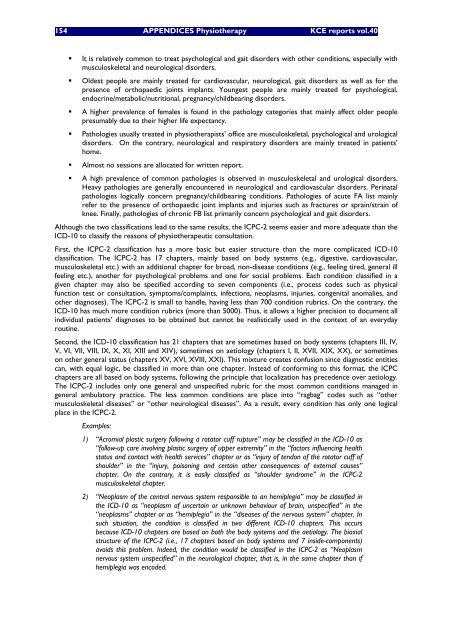Appendices - KCE
Appendices - KCE
Appendices - KCE
You also want an ePaper? Increase the reach of your titles
YUMPU automatically turns print PDFs into web optimized ePapers that Google loves.
154 APPENDICES Physiotherapy <strong>KCE</strong> reports vol.40<br />
It is relatively common to treat psychological and gait disorders with other conditions, especially with<br />
musculoskeletal and neurological disorders.<br />
Oldest people are mainly treated for cardiovascular, neurological, gait disorders as well as for the<br />
presence of orthopaedic joints implants. Youngest people are mainly treated for psychological,<br />
endocrine/metabolic/nutritional, pregnancy/childbearing disorders.<br />
A higher prevalence of females is found in the pathology categories that mainly affect older people<br />
presumably due to their higher life expectancy.<br />
Pathologies usually treated in physiotherapists office are musculoskeletal, psychological and urological<br />
disorders. On the contrary, neurological and respiratory disorders are mainly treated in patients<br />
home.<br />
Almost no sessions are allocated for written report.<br />
A high prevalence of common pathologies is observed in musculoskeletal and urological disorders.<br />
Heavy pathologies are generally encountered in neurological and cardiovascular disorders. Perinatal<br />
pathologies logically concern pregnancy/childbearing conditions. Pathologies of acute FA list mainly<br />
refer to the presence of orthopaedic joint implants and injuries such as fractures or sprain/strain of<br />
knee. Finally, pathologies of chronic FB list primarily concern psychological and gait disorders.<br />
Although the two classifications lead to the same results, the ICPC-2 seems easier and more adequate than the<br />
ICD-10 to classify the reasons of physiotherapeutic consultation.<br />
First, the ICPC-2 classification has a more basic but easier structure than the more complicated ICD-10<br />
classification. The ICPC-2 has 17 chapters, mainly based on body systems (e.g., digestive, cardiovascular,<br />
musculoskeletal etc.) with an additional chapter for broad, non-disease conditions (e.g., feeling tired, general ill<br />
feeling etc.), another for psychological problems and one for social problems. Each condition classified in a<br />
given chapter may also be specified according to seven components (i.e., process codes such as physical<br />
function test or consultation, symptoms/complaints, infections, neoplasms, injuries, congenital anomalies, and<br />
other diagnoses). The ICPC-2 is small to handle, having less than 700 condition rubrics. On the contrary, the<br />
ICD-10 has much more condition rubrics (more than 5000). Thus, it allows a higher precision to document all<br />
individual patients diagnoses to be obtained but cannot be realistically used in the context of an everyday<br />
routine.<br />
Second, the ICD-10 classification has 21 chapters that are sometimes based on body systems (chapters III, IV,<br />
V, VI, VII, VIII, IX, X, XI, XIII and XIV), sometimes on aetiology (chapters I, II, XVII, XIX, XX), or sometimes<br />
on other general status (chapters XV, XVI, XVIII, XXI). This mixture creates confusion since diagnostic entities<br />
can, with equal logic, be classified in more than one chapter. Instead of conforming to this format, the ICPC<br />
chapters are all based on body systems, following the principle that localization has precedence over aetiology.<br />
The ICPC-2 includes only one general and unspecified rubric for the most common conditions managed in<br />
general ambulatory practice. The less common conditions are place into ragbag codes such as other<br />
musculoskeletal diseases or other neurological diseases . As a result, every condition has only one logical<br />
place in the ICPC-2.<br />
Examples:<br />
1) Acromial plastic surgery following a rotator cuff rupture may be classified in the ICD-10 as<br />
follow-up care involving plastic surgery of upper extremity in the factors influencing health<br />
status and contact with health services chapter or as injury of tendon of the rotator cuff of<br />
shoulder in the injury, poisoning and certain other consequences of external causes<br />
chapter. On the contrary, it is easily classified as shoulder syndrome in the ICPC-2<br />
musculoskeletal chapter.<br />
2) Neoplasm of the central nervous system responsible to an hemiplegia may be classified in<br />
the ICD-10 as neoplasm of uncertain or unknown behaviour of brain, unspecified in the<br />
neoplasms chapter or as hemiplegia in the diseases of the nervous system chapter. In<br />
such situation, the condition is classified in two different ICD-10 chapters. This occurs<br />
because ICD-10 chapters are based on both the body systems and the aetiology. The biaxial<br />
structure of the ICPC-2 (i.e., 17 chapters based on body systems and 7 inside-components)<br />
avoids this problem. Indeed, the condition would be classified in the ICPC-2 as Neoplasm<br />
nervous system unspecified in the neurological chapter, that is, in the same chapter than if<br />
hemiplegia was encoded.

















